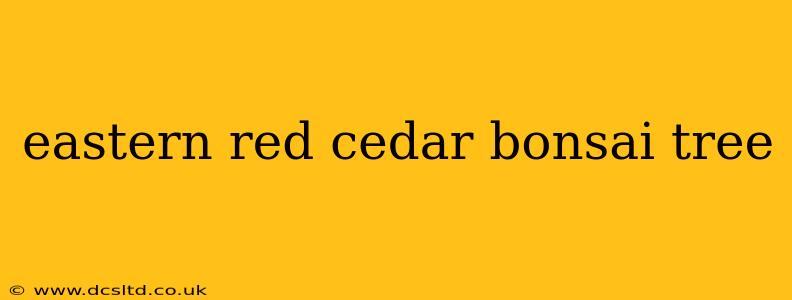The Eastern Red Cedar (Juniperus virginiana) boasts a rugged beauty that translates remarkably well into the art of bonsai. Its resilience, adaptability, and naturally interesting branching structure make it a popular choice for both beginners and experienced bonsai enthusiasts. This comprehensive guide delves into the intricacies of cultivating a stunning Eastern Red Cedar bonsai, addressing common questions and offering expert advice.
What Makes Eastern Red Cedar a Good Bonsai Choice?
The Eastern Red Cedar's popularity in bonsai stems from several key factors. Its fine textured foliage allows for the creation of miniature landscapes, its ability to withstand pruning and shaping is exceptional, and its tolerance of various soil conditions and climates contributes to its ease of care. Furthermore, its berries and the overall shape of the tree add visual interest, contributing to a unique and beautiful bonsai specimen.
How Do I Care for an Eastern Red Cedar Bonsai?
Caring for your Eastern Red Cedar bonsai involves understanding its specific needs. This includes proper watering, fertilization, pruning, and repotting techniques. Let's explore each aspect in detail:
Watering Your Eastern Red Cedar Bonsai
Consistent moisture is crucial, but avoid overwatering, which can lead to root rot. Water thoroughly when the top inch of soil feels dry. The frequency will depend on factors such as climate, pot size, and season. During hotter months, you may need to water more frequently. Good drainage is essential to prevent waterlogging.
Fertilizing Your Eastern Red Cedar Bonsai
Feed your Eastern Red Cedar bonsai with a balanced, diluted liquid fertilizer during the growing season (spring and summer). Avoid fertilizing during the dormant period (fall and winter). Over-fertilization can damage the tree, so follow the instructions on your chosen fertilizer carefully.
Pruning and Shaping Your Eastern Red Cedar Bonsai
Regular pruning is vital for maintaining the desired shape and size of your bonsai. Pinch back new growth regularly to encourage branching and maintain density. More extensive pruning can be done in late winter or early spring before new growth begins. Always use sharp, clean pruning shears to prevent disease.
Repotting Your Eastern Red Cedar Bonsai
Repotting is necessary every 2-3 years, or when the roots become root-bound. This allows for fresh soil and improved drainage. The best time for repotting is in early spring. During repotting, carefully remove some of the older, coarser roots to encourage new root growth.
What are the Common Problems with Eastern Red Cedar Bonsai?
While relatively hardy, Eastern Red Cedars can be susceptible to certain problems.
Pest and Disease Problems
Cedar apple rust is a common fungal disease that affects Eastern Red Cedars. Regular inspection and prompt treatment with appropriate fungicides are crucial if infection occurs. Other potential pests include spider mites and scale insects. Addressing these problems early is key to maintaining the health of your bonsai.
Root Rot
Overwatering is the primary cause of root rot. Ensure your pot has adequate drainage and avoid letting the soil remain soggy.
Needle Blight
This fungal disease can affect the needles, causing browning and defoliation. Proper sanitation and fungicide application can help manage this problem.
How Often Should I Repot My Eastern Red Cedar Bonsai?
Repotting your Eastern Red Cedar bonsai is typically recommended every 2-3 years, or as needed when roots become bound. This allows for fresh soil and improved drainage, supporting healthy growth.
What Type of Soil Is Best for an Eastern Red Cedar Bonsai?
A well-draining bonsai soil mix is essential for Eastern Red Cedars. A mix of akadama, pumice, and lava rock is often recommended. This blend provides excellent aeration and drainage, preventing waterlogging and root rot.
How Do I Propagate an Eastern Red Cedar Bonsai?
Propagation of Eastern Red Cedar can be done through cuttings or seeds. Cuttings taken from semi-hardwood in summer have a higher success rate. Seed propagation is also possible, but requires more patience.
By carefully following these guidelines, you can successfully cultivate a magnificent Eastern Red Cedar bonsai that will bring years of enjoyment and aesthetic pleasure. Remember that bonsai cultivation is a journey, requiring patience and dedication. The rewards, however, are immeasurable.
